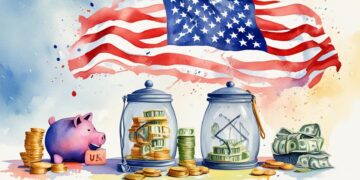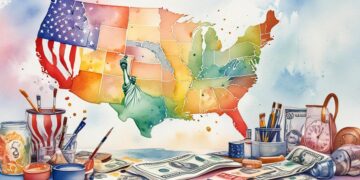Steps to Achieve Financial Freedom Faster

Understanding Financial Freedom
Achieving financial freedom is about gaining control over your financial decisions and reclaiming your time. It allows you to make choices that align with your values and aspirations, rather than feeling trapped by monetary constraints. With the increasing cost of living and unexpected expenses, many individuals in the United States find it challenging to attain this state of financial independence. However, by implementing specific strategies, you can systematically move closer to this goal.
Create a Budget
One of the first steps towards financial freedom is to create a budget. This involves tracking your income and expenses over a set period, usually a month. By categorizing your spending—such as rent, groceries, transportation, and entertainment—you can identify areas where you may be overspending.
For example, if you notice that dining out frequently is consuming a large portion of your budget, you might consider cutting back on restaurant meals and cooking at home instead. Various budgeting apps, like Mint or YNAB (You Need A Budget), can help you visualize your financial situation and stick to your plan.
Build an Emergency Fund
Next, focus on building an emergency fund. Financial experts recommend saving three to six months’ worth of living expenses. This fund acts as a safety net for unexpected scenarios, such as medical emergencies, car repairs, or job losses. Without an emergency fund, people often resort to credit cards or loans, which can lead to crippling debt.
Start by setting small monthly savings goals. For instance, if your monthly expenses total $3,000, aim to save at least $250 each month. Over time, these contributions will accumulate, providing you with peace of mind during financial upheavals.
Pay Off Debt
Another crucial step is to pay off debt, especially high-interest debts like credit cards. The longer you carry these debts, the more interest accrues, making it harder to achieve financial freedom. To tackle this, you can use methods like the avalanche method, where you prioritize paying off debts with the highest interest rates first, or the snowball method, which focuses on paying off the smallest debts first for psychological wins.
For example, if you have three credit cards with balances of $1,000, $2,000, and $5,000, identify which one has the highest rate. Focus your extra payments on that card while making minimum payments on the others.
Invest Wisely
Once you are stable with your budget and debt repayment, invest wisely. Look into options like stock market investments through a 401(k) or IRA, and consider diversifying into real estate. Investing allows your money to grow over time, creating a powerful wealth-building strategy.
For instance, starting a retirement account early can yield substantial returns due to compound interest. If you invest $5,000 annually in an account that earns a 7% return, you could accumulate over $1 million in 30 years!
Increase Your Income
Lastly, consider ways to increase your income. This could involve asking for a raise, pursuing further education or certifications to boost your qualifications, or taking on a side hustle. Side gigs such as freelancing, pet sitting, or driving for rideshare services can provide additional cash flow to enhance your savings and investments.
For example, if you spend 10 hours a week on a side gig that pays $25 per hour, you could earn an extra $250 weekly, significantly boosting your financial stability.
By taking these actionable steps, you can create a structured path towards financial independence. Start small, stay consistent, and remember that financial freedom is not just a dream—it is an attainable goal. With every positive financial decision, you are one step closer to living life on your own terms, free from financial worries.
CHECK OUT: Click here to explore more
Essential Steps Toward Financial Freedom
Moving toward financial freedom requires a disciplined approach to managing your finances. It’s not just about how much money you earn, but how effectively you handle that money. Let’s explore some essential steps that can accelerate your journey toward financial independence.
Set Clear Financial Goals
Before diving into budgeting and investments, it’s crucial to set clear financial goals. Having specific, measurable objectives gives you something to aim for and helps you stay motivated. Consider breaking your goals into short-term, medium-term, and long-term categories:
- Short-term goals: These could include saving for a vacation or paying off a specific debt within a year.
- Medium-term goals: Perhaps you want to save for a home down payment or fund further education over the next three to five years.
- Long-term goals: This typically involves retirement savings or building a significant investment portfolio over 20 years or more.
Write these goals down and keep them visible. This practice serves as a constant reminder of your financial aspirations, making it easier to resist unnecessary expenditures.
Track Your Progress
Once your goals are set, tracking your progress becomes essential. This means regularly revisiting your budget and financial plans to see how well you are doing. Set a schedule—monthly, quarterly, or annual—to assess whether your spending aligns with your goals.
Utilize financial tracking tools or even simple spreadsheets to monitor your expenses and savings. When you see how close you are to achieving your goals, it can provide the motivation needed to stay committed. Celebrate small victories along the way; it reinforces positive behavior.
Reduce Unnecessary Expenses
Another effective way to hasten your journey to financial freedom is to reduce unnecessary expenses. Often, we subscribe to services or make purchases that we don’t fully utilize. Start by reviewing your bills and monthly expenses to identify areas of potential savings:
- Cable or streaming services—do you really use all of them?
- Subscriptions—can any be canceled or temporarily paused?
- Dining out—are there meals you can prepare at home instead?
Consider implementing the 30-day rule before making any large purchases. This means waiting 30 days to determine if a purchase is necessary. Often, you’ll find that the impulse to buy fades over time.
Educate Yourself Financially
Investing the time to educate yourself financially can pay dividends in the long run. Read books, listen to podcasts, or take courses related to personal finance and investing. Understanding the basics of finance empowers you to make informed decisions about your money.
You might start by focusing on topics like compound interest, asset allocation, and the power of diversification. Knowledge builds confidence, enabling you to navigate financial challenges more effectively and spot opportunities for growth.
By incorporating these vital steps into your financial strategy, you’re setting the foundation for a more secure and independent future. Remember, achieving financial freedom is a marathon, not a sprint, and each step you take today brings you closer to enjoying the life you want without financial constraints.
SEE ALSO: Click here to read another article
Creating Your Financial Roadmap
To navigate the path to financial freedom effectively, it’s essential to create a comprehensive financial roadmap. This involves not only sticking to your budget and reducing expenses but also actively working on wealth-building strategies. Let’s examine some proactive financial practices that can significantly speed up your journey to financial independence.
Build an Emergency Fund
One of the cornerstones of financial stability is having an emergency fund. This fund acts as a financial safety net, providing peace of mind in case of unforeseen expenses, such as medical emergencies or car repairs. Aim to save at least three to six months’ worth of living expenses.
Start small; even an initial savings of $1,000 can give you a buffer against minor financial setbacks. Once you’ve established that, gradually build it to cover essential costs for a longer period. This preparation allows you to focus on long-term financial goals without the anxiety of unexpected expenses derailing your plans.
Eliminate High-Interest Debt
Many people find themselves shackled by high-interest debt, such as credit card debt, which can be a significant obstacle to financial freedom. Prioritize paying off these debts as quickly as possible through methods like the snowball or avalanche techniques:
- Snowball Method: Focus on paying off the smallest debts first to build momentum and motivation.
- Avalanche Method: Concentrate on the debts with the highest interest rates to save money on interest in the long run.
Consider consolidating your debts for potentially lower interest rates, which can also simplify payments. Reducing this financial burden frees up more of your income to direct toward savings and investments.
Invest in Your Future
Investing is an essential tool for building wealth and should not be overlooked in your strategy for financial freedom. Starting early can yield exponential returns due to the power of compound interest. Here are a few investment avenues to consider:
- Retirement Accounts: Contribute to tax-advantaged accounts like a 401(k) or an IRA. If your employer matches contributions, make sure to take full advantage of this benefit.
- Index Funds and ETFs: These investment vehicles often feature lower costs and provide diversification through exposure to a range of companies.
- Real Estate: Consider investing in rental properties as a way to generate passive income, although make sure to research the responsibilities and potential challenges involved.
Diversifying your investments can mitigate risk, making it crucial to seek guidance from a financial advisor if needed. Remember, the earlier you invest, the less you need to set aside each month to reach your long-term financial objectives.
Develop Passive Income Streams
To expedite your journey to financial freedom, focus on creating passive income streams. This means earning money with minimal ongoing effort. Popular strategies to build passive income include:
- Dividend Stocks: Investing in companies that pay dividends can provide a steady income source while allowing your investment to grow.
- Rental Income: Leasing property can generate reliable monthly income, albeit with the upfront investment and effort of property management.
- Creating Online Content: Monetizing blogs, YouTube channels, or online courses can potentially bring in income while allowing for creative freedom.
Investing your time initially to set up these income sources can lead to substantial financial benefits down the line, helping you achieve your financial freedom goals faster.
SEE ALSO: Click here to read another article
Conclusion
Achieving financial freedom is a rewarding journey that requires intentional planning, dedication, and informed decision-making. By implementing the various strategies discussed, you can expedite your path to independence. Start with building an emergency fund to cushion against unforeseen financial challenges, enabling you to stay on track with your goals. Prioritizing the elimination of high-interest debt is crucial; it frees up valuable resources that can be redirected towards investments and savings.
Investing in your future is indispensable; whether through retirement accounts, index funds, or real estate, each pour of effort into your financial plan can lead to significant long-term benefits. Lastly, fostering passive income streams allows your money to work for you, creating additional financial security with less ongoing effort.
As you reinforce these practices and make them a regular part of your life, remember that financial freedom is not merely an endpoint but a journey of continual improvement and learning. Stay informed about your options, revisit your strategies regularly, and adjust as necessary. With commitment and wise financial choices, attaining a state of financial independence is not only possible but can be achieved more quickly than you might think. Take action today, and step confidently towards the freedom you desire.

Linda Carter is a writer and financial consultant specializing in personal finance and money management. With years of experience helping individuals and families achieve financial stability and make informed decisions, Linda shares her expertise on the True Metronome platform. Her goal is to empower readers with practical advice and strategies to take control of their finances and build a secure future.





